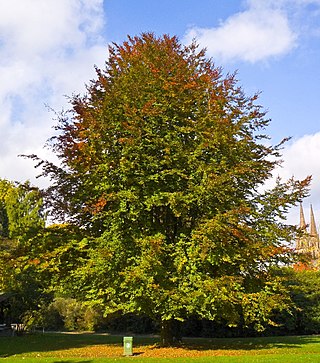
The Fagaceae are a family of flowering plants that includes beeches, chestnuts and oaks, and comprises eight genera with about 927 species. Fagaceae in temperate regions are mostly deciduous, whereas in the tropics, many species occur as evergreen trees and shrubs. They are characterized by alternate simple leaves with pinnate venation, unisexual flowers in the form of catkins, and fruit in the form of cup-like (cupule) nuts. Their leaves are often lobed, and both petioles and stipules are generally present. Their fruits lack endosperm and lie in a scaly or spiny husk that may or may not enclose the entire nut, which may consist of one to seven seeds. In the oaks, genus Quercus, the fruit is a non-valved nut called an acorn. The husk of the acorn in most oaks only forms a cup in which the nut sits. Other members of the family have fully enclosed nuts. Fagaceae is one of the most ecologically important woody plant families in the Northern Hemisphere, as oaks form the backbone of temperate forest in North America, Europe, and Asia, and are one of the most significant sources of wildlife food.
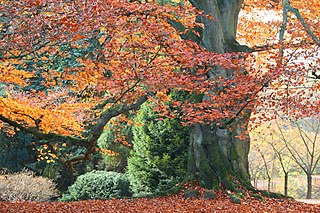
Beech (Fagus) is a genus of deciduous trees in the family Fagaceae, native to temperate Eurasia and North America. There are 13 accepted species in two distinct subgenera, Engleriana and Fagus. The subgenus Engleriana is found only in East Asia, distinctive for its low branches, often made up of several major trunks with yellowish bark. The better known Fagus subgenus beeches are native to Europe and North America. They are high-branching trees with tall, stout trunks and smooth silver-grey bark. The European beech Fagus sylvatica is the most commonly cultivated species, yielding a utility timber used for furniture construction, flooring and engineering purposes, in plywood, and household items. The timber can be used to build homes. Beechwood makes excellent firewood. Slats of washed beech wood are spread around the bottom of fermentation tanks for Budweiser beer. Beech logs are burned to dry the malt used in some German smoked beers. Beech is also used to smoke Westphalian ham, andouille sausage, and some cheeses.

Quercus suber, commonly called the cork oak, is a medium-sized, evergreen oak tree in the section Quercus sect. Cerris. It is the primary source of cork for wine bottle stoppers and other uses, such as cork flooring and as the cores of cricket balls. It is native to southwest Europe and northwest Africa. In the Mediterranean basin the tree is an ancient species with fossil remnants dating back to the Tertiary period. It can survive for as long as two centuries. Typically, once it reaches 25 years old, its thick bark can be harvested for cork every 9 to 12 years without causing harm to the tree.

Fagus sylvatica, the European beech or common beech, is a large, graceful deciduous tree in the beech family with smooth silvery-gray bark, large leaf area, and a short trunk with low branches.

Fagus grandifolia, the American beech or North American beech, is the only species of beech native to North America. Its current range comprises the eastern United States, isolated pockets of Mexico and southeastern Canada. Prior to the glacial maximum of the Pleistocene epoch, the tree flourished over most of North America, reaching California.

Quercus faginea, the Portuguese oak, is a species of oak native to the western Mediterranean region in the Iberian Peninsula. Similar trees in the Atlas Mountains of northwest Africa are usually included in this species, or sometimes treated as a distinct species, Quercus tlemcenensis. It occurs in mountains from sea level to 1,900 metres above sea level, and flourishes in a variety of soils and climates. Out of all the oak forests in the Iberian Peninsula, the southern populations of Portuguese oak were found to have the highest diversity and endemism of spider species.

Beech bark disease is a disease that causes mortality and defects in beech trees in the eastern United States, Canada and Europe. In North America, the disease occurs after extensive bark invasion by Xylococculus betulae and the beech scale insect, Cryptococcus fagisuga. Through a presently unknown mechanism, excessive feeding by this insect causes two different fungi to produce annual cankers on the bark of the tree. The continuous formation of lesions around the tree eventually girdles it, resulting in canopy death. In Europe, N. coccinea is the primary fungus causing the infection. Infection in European trees occurs in the same manner as it does in North American trees. Though the disease still appears in Europe, it is less serious today than it once was.
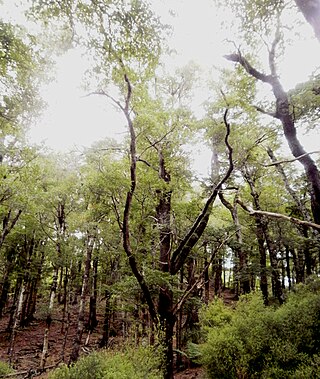
Nothofagus truncata, or hard beech, is a species of tree endemic to New Zealand. Its common name derives from the fact that the timber has a high silica content, making it tough and difficult to saw. Hard beech is a tree up to 30m tall occurring in lowland and lower montane forest from latitude 35°S to 42°30'S, that is, from the north of the North Island southwards to Marlborough and south Westland in the South Island. In Taranaki it forms almost pure stands on the rugged sandstone country there and is partially deciduous, dropping many of its leaves at the end of the winter. N. truncata became known as Fuscospora truncata after 2013 in New Zealand.
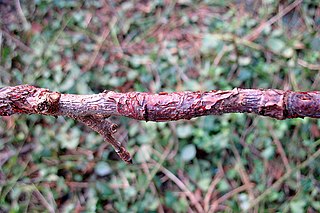
Neonectria ditissima is a fungal plant pathogen. It causes cankers that can kill branches of trees by choking them off. Apple and beech trees are two susceptible species.

Phytophthora × cambivora is a plant pathogen that causes ink disease in European chestnut trees. Ink disease, also caused by Phytophthora cinnamomi, is thought to have been present in Europe since the 18th century, and causes chestnut trees to wilt and die; major epidemics occurred during the 19th and 20th centuries. P. cinnamomi and P. × cambivora are now present throughout Europe since the 1990s. Ink disease has resurged, often causing high mortality of trees, particularly in Portugal, Italy, and France. It has also been isolated from a number of different species since the 1990s, including:

Fagus crenata, known as Siebold's beech, or Japanese beech, is a species of deciduous tree in the family Fagaceae.

The black arches or nun moth is a small Palaearctic moth. It is considered a forest pest.

The English Lowlands beech forests is a terrestrial ecoregion in the United Kingdom, as defined by the World Wide Fund for Nature (WWF) and the European Environment Agency (EEA). It covers 45,600 km2 (17,600 sq mi) of Southern England, approximately as far as the border with Devon and South Wales in the west, into the Severn valley in the north-west, into the East Midlands in the north, and up to the border of Norfolk in the north-east. The WWF code for this ecoregion is PA0421.

Nummus is a Latin word for various coins that was borrowed from Doric Greek noummos. Originally referring to a specific style of coin used in Greek-speaking Southern Italy, the term nummus came to be used by the Late Republic for all coins generally and particularly as a synonym for the sestertius, then the standard unit of Roman accounting, and then in Late Antiquity as the formal name of the follis. It was used in this general sense in Early Modern English but is most commonly employed by modern numismatists as a catchall term for various low-value copper coins issued by the Roman and Byzantine empires during Late Antiquity.
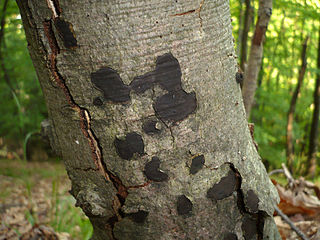
Biscogniauxia is a genus of fungi in the family Xylariaceae. Subtaxa include Biscogniauxia capnodes var. capnodes, Biscogniauxia marginata and Biscogniauxia nummularia, which are plant pathogens. The genus was circumscribed by Otto Kuntze in Revis. Gen. Pl. 2 on page 398 in 1891.

Phytophthora kernoviae is a plant pathogen that mainly infects European beech and Rhododendron ponticum. It was first identified in 2003 in Cornwall, UK when scientists were surveying for the presence of Phytophthora ramorum. This made it the third new Phytophthora species to be found in the UK in a decade. It was named Phytophthora kernoviae after the ancient name for Cornwall, Kernow. It causes large stem lesions on beech and necrosis of stems and leaves of Rhododendron ponticum. It is self-fertile. It has also been isolated from Quercus robur and Liriodendron tulipifera. The original paper describing the species, stated it can infect Magnolia and Camellia species, Pieris formosa, Gevuina avellana, Michelia doltsopa and Quercus ilex. Since then many other plants have been identified as natural hosts of the pathogen. Molecular analysis has revealed that an infection on Pinus radiata, recorded in New Zealand in 1950, was caused by P. kernoviae. The pathogen was also noted on Drimys winteri, Gevuina avellana, Ilex aquifolium, Quercus ilex, Vaccinium myrtillus, Hedera helix, Podocarpus salignas.

Cryptococcus fagisuga, commonly known as the beech scale or woolly beech scale, is a felted scale insect in the superfamily Coccoidea that infests beech trees of the genus Fagus. It is associated with the transmission of beech bark disease because the puncture holes it makes in the bark allow entry of pathogenic fungi which have been identified as Nectria coccinea var. faginata and sometimes Nectria galligena.
Phytophthora pseudosyringae is a semi-papillate homothallic soil-borne plant pathogen causing root and collar rot of broadleaf tree species in Europe. It is associated with necrotic fine roots and stem necroses of Fagus sylvatica and Alnus glutinosa, and isolates are moderately aggressive to fine roots of oaks and beech (Nothofagus), highly aggressive to holly leaves and apple fruits, and slightly pathogenic to alder bark. It belongs to the class of oomycetes and is often described as a ‘fungal-like’ organism since they form a heterotrophic mycelium as the ‘true fungi’, but in contrast, their cell wall lacks chitin and is composed only of cellulose and glucans.

Aceria nervisequa is a species of mite that belongs to the family Eriophyidae. It is found in Europe and was first described by Giovanni Canestrini in 1891. The mite causes galls on the leaves of beech,

Diatrype virescens is a carbonaceous pyrenomycete in the family Diatrypaceae. It grows uniquely on the wood of American beech in North America. Its growth structure is immersed, popping out from under the bark in scattered green fruiting bodies which soon fade to black.






















